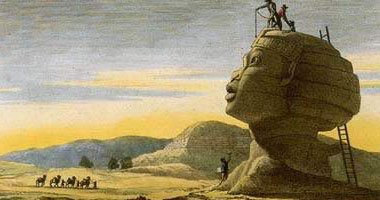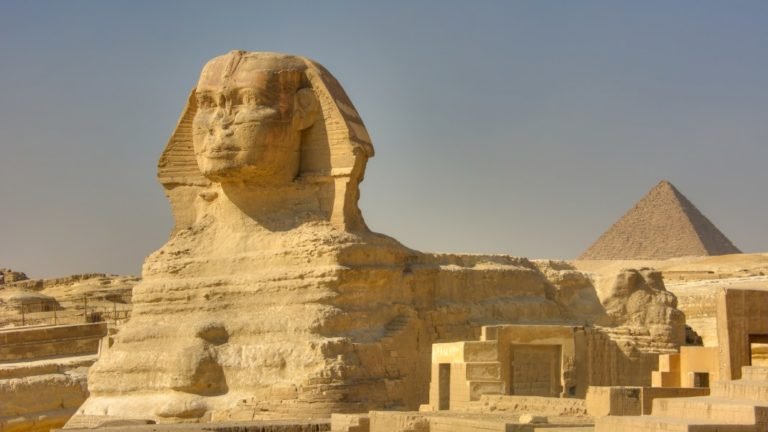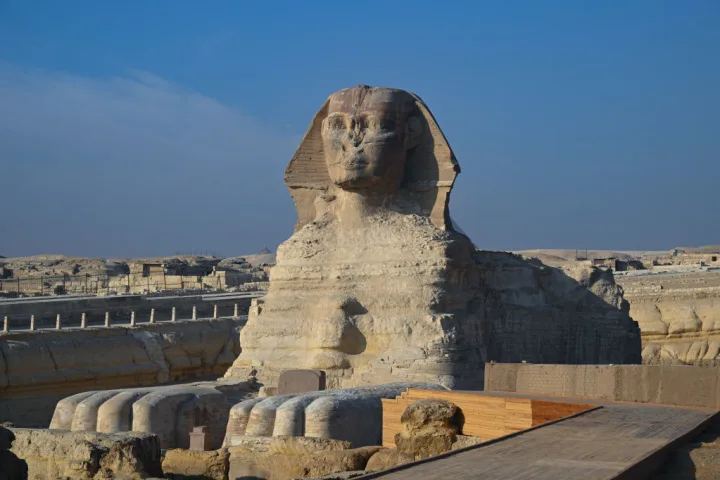The Great Sphinx of Giza, an enduring symbol of ancient Egypt, has captivated humanity for centuries, concealing its mysteries beneath the relentless sun of the Giza Plateau. Let’s delve into the enigma of the Sphinx, exploring its hidden tunnels, secrets, and chambers.
The Sphinx Of Giza
The Great Sphinx of Giza is a massive statue in Egypt that resembles a combination of a person and a lion. Crafted approximately 4,500 years ago during the reign of the ancient Egyptian ruler Pharaoh Khafre, the statue measures about 73 meters in length, 20 meters in height, and 19 meters in width. It is renowned for facing from west to east.
A mystery surrounds its missing nose – some initially believed it broke during a war, but it turns out this occurred much earlier, and the exact cause remains uncertain. Despite its age, the Sphinx remains a symbol of ancient Egypt’s skill and creativity, inviting people to explore its history and secrets.
The Tunnels
Beneath the colossal paws of the Sphinx of Giza, hidden tunnels wind through the bedrock of Giza. Once overlooked, these passageways have become a focal point for archaeological exploration. Recent studies reveal a labyrinthine network, prompting experts to question their purpose.
Some suggest these tunnels served as conduits for rituals, while others propose a more practical function, possibly connecting the Sphinx of Giza to nearby structures. The significance of these subterranean passages unveils a narrative of both practical engineering and sacred symbolism, offering a glimpse into the complexities of ancient Egyptian society.
The Enigmatic Tunnels
Perring’s Hole
Meticulously crafted around the Sphinx’s head in the 1840s by Howard Vyse, Perring’s Hole raises questions about its purpose, providing a tangible connection to 19th-century exploration.

Eastern Shaft
Sealed with a trap door in the 1920s during restoration efforts, the Eastern Shaft within the Sphinx’s paws stands as a testament to the determination to preserve the monument’s integrity for future generations.
Shaft A
Perched atop the Sphinx’s head, Shaft A’s deep hole sparks intriguing speculations about its role, leaving us to ponder its potential connection to ancient headdress affixing.
Shaft C
A square shaft with a dead-end at the Sphinx’s back, Shaft C adds to the mystery, prompting contemplation about its purpose and historical significance.
Shaft D
Descending to the water table below the Sphinx, Shaft D’s passage beneath the hind paws opens doors to exploration around 4.5 meters below the surface, revealing hidden secrets.
Keyhole Shaft
Shrouded in speculation, the Keyhole Shaft introduces the possibility of an unfinished tomb, adding layers to the Sphinx’s enigmatic narrative and sparking curiosity about its untold story.
Chambers within the Sphinx
The concept of hidden chambers within the Sphinx of Giza has fueled speculation and excitement. While some chambers have been discovered, the possibility of unexplored spaces continues to intrigue archaeologists and enthusiasts alike.
Hall of Records
Fables of hidden chambers, including a mythical “Hall of Records” beneath the Sphinx, have fueled imaginations for centuries. However, these claims lack concrete evidence, challenging modern explorers to separate fact from fiction.

FAQs
Are there undiscovered chambers within the Sphinx?
While some chambers have been unearthed, the possibility of undiscovered spaces persists. Ongoing research and technological advancements may reveal more about the hidden recesses of the Sphinx.
What do hieroglyphs on the Sphinx reveal?
Hieroglyphs on the Sphinx provide insights into religious rituals, offerings, and the monument’s role in ancient Egyptian beliefs. They contribute to our understanding of the Sphinx’s cultural and spiritual significance.
Why are tunnels present beneath the Sphinx?
The purpose of the tunnels remains uncertain. Theories range from burial chambers to religious rituals, and ongoing excavations aim to unravel the true function of these passageways.
Conclusion
As we navigate the depths of the Sphinx’s mysteries, we uncover a tale of ancient aspirations, abandonment, restoration, and the timeless allure of an enigmatic monument. The Sphinx of Giza, with its hidden tunnels and secrets, remains a beacon of fascination, inviting future generations to continue the quest for understanding the secrets held within its ancient embrace.

